TWiLiTE (Tropospheric Wind Lidar Technology Experiment)
Airborne Sensors
TWiLiTE (Tropospheric Wind Lidar Technology Experiment)
TWiLiTE is an airborne Doppler lidar technology project of NASA which was selected in 2005 by the ESTO (Earth Science Technology Office) as part of the Instrument Incubator Program (IIP). The overall objective is to advance the technology readiness level of the key technologies and subsystems of a molecular direct detection wind lidar system by validating them, at the system level, in an integrated airborne lidar system. The TWiLiTE Doppler lidar system is designed for autonomous operation on NASA high altitude research aircraft such as the WB57 or ER-2. 1) 2) 3) 4)
These aircraft are capable of flying well above the mid-latitude tropopause so the downward looking lidar will measure complete profiles of the horizontal wind field through the lower stratosphere and the entire troposphere. The completed system will profile winds in clear air from aircraft flight altitudes of 18 km to the surface with 250 m vertical resolution and a velocity precision of < 3 m/s.
Wavelength of lidar | 355 nm (UV range) |
HOE (Holographic Optical Element) telescope/scanner aperture | 0.38 m diameter |
Laser linewidth at FWHH (Full Width Half-Height) | < 150 MHz @ 355 nm |
Laser energy/pulse | 35 mJ |
Laser pulse repetition frequency | 200 Hz |
Etalon FSR (Free Space Range) | 16.7 GHz |
Etalon FWHH | 2.84 GHz |
Etalon peak transmission | > 60 % |
Interference filter BW (FWHH) | 220 pm |
PMT quantum efficiency | 25% |
The TWiLiTE airborne scanning direct detection molecular Doppler lidar system will be the first of its kind, and as such, can be flown as a stand-alone instrument or with existing, or future, aerosol Doppler lidars to explore the potential synergies of data products, systems and shared technologies of the hybrid approach.
The TWiLiTE project is a collaboration involving scientists and engineers from NASA/GSFC (Goddard Space Flight Center), NOAA, Utah State University / Space Dynamics Laboratory (USU/SDL), Michigan Aerospace Corporation, Fibertek Inc, and Sigma Space Corporation.
The TWiLiTE lidar system is composed of four major subsystems:
1) The single frequency pulsed laser transmitter
2) The transceiver telescope and scanner
3) The Doppler receiver
4) The C&DH (Command and Data Handling) electronics that control the instrument functions and acquire and store the science data.
The TWiLiTE Doppler lidar is designed to be fully autonomous in operation. There are only the top level commands to power the instrument on or off; allow or inhibit the laser firing and begin data acquisition. All other functions are controlled internally in flight.
TWiLiTE is a direct detection Doppler lidar designed to measure winds using the signal backscattered by molecules. The Doppler frequency shift is measured with a molecular double edge receiver. The double edge method utilizes two high spectral resolution optical filters located symmetrically about the outgoing laser frequency to measure the Doppler shift. The double edge concept is shown in Figure 1.
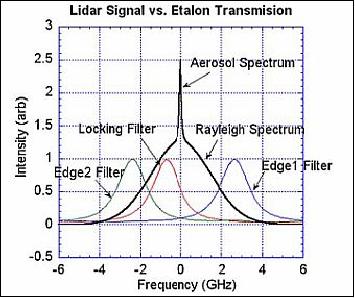
Legend to Figure 1: The two edge filter channels are shown symmetrically located about the outgoing laser frequency in the wings of the thermally broadened molecular backscattered spectrum.
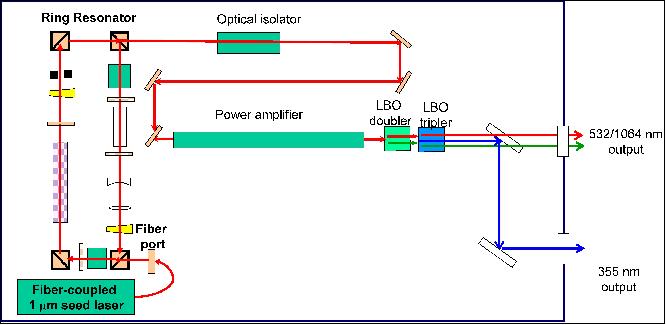
To make the wind measurement, the two edge filter channels sample the intensity in the wings of the thermally broadened Rayleigh-Brillouin molecular backscattered spectrum. The ratio of the two edge filter transmission measurements will change in proportion to the speed and direction of the wind. Precise knowledge of the filter characteristics, detector properties and receiver optical throughput is obtained in calibration. The outgoing laser frequency is also measured to provide a zero Doppler reference.
The molecular system operates in the ultraviolet at 355 nm in order to take advantage of the λ-4 dependence of the molecular scattering. Many of the design elements of the TWiLiTE lidar have been demonstrated and validated in ground-based lidar measurements.
The transmitter is a single frequency, Nd:YAG laser frequency tripled to the third harmonic wavelength. The laser pulse energy is nominally 35 mJ at 355 nm and the pulse repetition frequency is 200 Hz. To obtain single frequency narrowband output pulses, the laser is injection seeded using a ramp-and-fire resonance locking technique. The ramp and fire technique is particularly suitable for airborne operation as it is relatively insensitive to vibration.
The laser features a MOPA (Master Oscillator Power Amplifier) configuration designed and built by Fibertek, Inc. The design has heritage to the High Brightness Laser, a NASA SBIR (Small Business Innovation Research) project that Fibertek completed in 2003. - The laser optics module is the gold irradiated pressure canister shown to the right and the laser electronics unit is the black box on the left (Figure 3). The laser optics module has dimensions of 31 cm x 25 cm x 14 cm. The laser draws about 480 W of electrical power from the aircraft 28V supply.
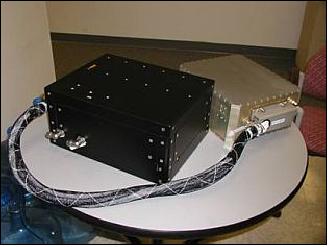
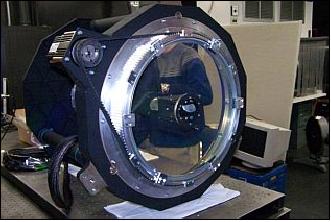
The telescope and conical-scanning functions are accomplished with a 38 cm clear aperture, rotating holographic optical element (HOE) transceiver. The HOE transceiver subsystem performs both functions of transmitting the laser beam and receiving the atmospheric backscattered signal.
The HOE aperture determines the receiver collecting area. The lidar measures the Doppler shift of the component of the wind projected on the line-of-sight of the laser beam. To resolve the horizontal wind, the HOE telescope is designed to direct the beam at a nadir angle of 45º. Rotation of the HOE repeatedly sweeps the transmitted laser beam and the receiver’s FOV (Field of View) through a 45º cone about the axis of rotation.
Note: The HOE is mounted in a ring bearing and rotates about its center normal to effect a 45º conical scan while the remainder of the telescope remain stationary. Preceded by two other similar telescopes at visible and near IR wavelengths, this is the first UV version of an HOE based telescope.
The scanner will step in azimuth to specified angles, typically 8 to 16 positions per scan cycle. After moving and settling to each fixed azimuth position the system will integrate signal for a period of 10 s (2000 laser shots). The backscattered signal collected by the HOE will be focused to a 200 µm core diameter multimode fiber optic which brings the collected signal to the Doppler receiver.
In the Doppler receiver, the collected signal is split into a total of four channels. Three of these beams are directed along parallel paths through a high spectral resolution tunable Fabry-Perot etalon which is used as the edge filter. The etalon channels have slightly different bandpass center frequencies but otherwise nearly identical optical properties e.g. peak transmission, finesse, free spectral range. The separation of the two edge filter center wavelengths is chosen so the velocity sensitivity of the broader molecular signal, defined as the change in the ratio of the two edge channel transmittances for a Doppler shift of 1 m/s, is equal to the velocity sensitivity of the narrower aerosol signal.
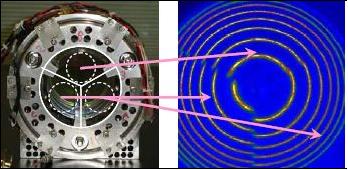
Legend of Figure 5: The TWiLiTE Fabry Perot etalon (left) has three sub-apertures with bandpasses separated in frequency to produce the molecular double edge measurement arrangement. The three spectral regions are clearly seen in the full fringe image of the Fabry Perot circular ring pattern shown on the right.
The two etalon ‘edge’ channels have PMTs (Photomultiplier Tubes) operating in photon counting mode. These channels provide the information used in the atmospheric Doppler shift measurement. The locking etalon peak is located such that the outgoing laser frequency is aligned to the half height point of the locking filter bandpass. This third etalon channel is used to sample the outgoing laser frequency and will be used as a reference in the Doppler shift measurement to correct for small frequency drifts of the laser or etalon. The fourth channel is an energy monitor used to provide intensity normalization of the respective etalon channels.
In each of the detector channels there are three Hamamatsu photomultiplier tubes sharing the incoming signal to that channel in the intensity ratio of 90:9:1. This arrangement allows the signal dynamic range of the photon counting PMTs to be increased by two orders of magnitude.
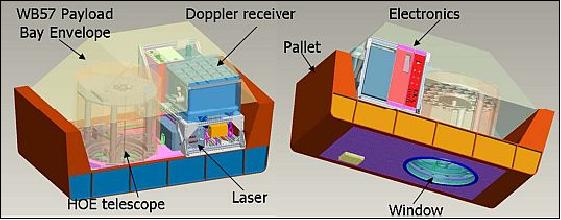
TWiLiTE Instrument Development Status
The TWiLiTE IIP project officially ended on August 1, 2008. The CDR (Critical Design Review) was completed on May 1, 2007. The major subsystem deliveries began in June, 2007 with the delivery of the etalon and controller, followed by the HOE telescope and Doppler receiver.
The final stage of the IIP project involves ground testing of the subsystems, completion of the command and data handling hardware and software and integration of all the modules into the complete instrument package.
This is being followed in the fall of 2008 by initial flight testing of the TWiLiTE instrument and later by regular observation flights.
TWiLiTE Installed on ER-2 Aircraft
In February, 2009 the TWiLiTE development program was completed and the instrument was shipped to Edwards AFB in California where it was integrated into the NASA ER-2 for initial engineering test flights. 5) 6) 7)
Several engineering flights of the TWiLiTE system were performed in February and September of 2009 as the culmination of the IIP effort. These engineering flights are an important step in the technology development phase of the project required to validate the key technologies “at the system level in a relevant environment.” In this case the relevant environment is the high altitude ER-2 research aircraft. The aircraft typically fly at altitudes above 19,800 m. Cruising speeds are 752 km/hour or 210 m/s.
These test flights demonstrated autonomous operation and key engineering functions of TWiLiTE and generated a wealth of engineering data. Detailed analysis of the data enabled the team to make the modifications necessary to correct many remaining issues.
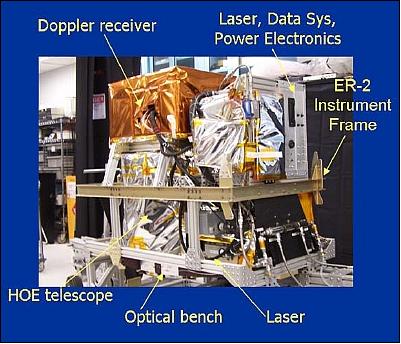
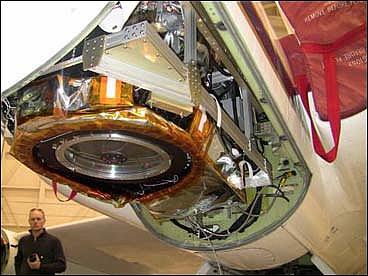
The TWiLiTE instrument assembly has a size of ~ 0.7 m (H) x 0.7 m (W) x 1.2 m (L), a mass of ~ 230 kg, and a total power demand of ~ 1 kW. The command, data handling and storage is managed by a single onboard computer. Atmospheric returns are detected by photomultiplier tubes and sampled in 3 channels of photon counting electronics. The raw data are stored to disk and processed post flight on the ground.

Legend to Figure 9: Data and fit are shown in top panel, residuals in the bottom panel. The three fringes are Edge Channel 1 (blue), Edge Channel 2 (red) and the Locking Reference Channel (brown). The y-axis is unity peak normalized intensity. The x-axis is the etalon gap increment in nm.
TWiLiTE is the first fully autonomous airborne Doppler wind lidar and represents a critical step on the path to a space based wind lidar system. This important development milestone was explicitly recommended by the Decadal Survey panel in their recommendations for the Global 3-D Winds Mission.
• On Feb. 17, 2011, TWiLiTE successfully completed engineering testing today at the NASA Dryden Aircraft Operations Facility in Palmdale, CA. 8)
References
1) Bruce Gentry, Matthew McGill, Geary Schwemmer, Michael Hardesty, Alan Brewer, Thomas Wilkerson, Robert Atlas, Marcos Sirota, Scott Lindemann, Floyd Hovis, “Status of the TWiLiTE airborne molecular Doppler lidar project,” ESTC2008 (Earth Science Technology Conference 2008), June 24-26, 2008, College Park, MD, USA, URL: http://esto.nasa.gov/conferences/estc2008/papers/Gentry_Bruce_B7P2.pdf
2) Bruce Gentry, Matthew McGill, Geary Schwemmer, Michael Hardesty, Alan Brewer, Thomas Wilkerson, Robert Atlas, Marcos Sirota, Scott Lindemann, Floyd Hovis, “Mid-term status of the TWiLiTE direct detection Doppler lidar development program,” NSTC2007 (NASA Science Technology Conference 2007), College Park, MD, USA, June 19-21, 2007, URL: http://esto.nasa.gov/conferences/nstc2007/papers/Gentry_Bruce__B11P2_NSTC-07-0123.pdf
3) B. Gentry, M. McGill, G. Schwemmer, M. Hardesty, A. Brewer, T. Wilkerson, R. ATLAS, M. Sirota, S. Lindemann, F. Hovis, “New technologies for direct detection of Doppler lidar: Status of the TWiLiTE airborne molecular Doppler lidar project,” ILRC24 (24th International Laser Radar Conference), Boulder, CO, USA, June 23-27, 2008, Vol. 1 (ISBN 978-0-615-21489-4), pp. 239-243
4) F. Hovis, J. Edelman, T. Schum, J. Rudd, K. Andes, B. Gentry, M. McGill, T. Cook, J. Hair, C. Hostetler, D. Harper, “Update on Single Frequency Laser Developments for the Tropospheric Wind Lidar Technology Experiment (TWiLiTE) and High Spectral Lidar (HSRL)/Ozone DIAL Instrument Incubator Program,,” Lidar Working Group, July 2008, URL: [web source no longer available]
5) Bruce Gentry, Matthew McGill, Roman Machan, Daniel Reed, Ryan Cargo, David J. Wilkens, William Hart, John Yorks, Stan Scott, Shane Wake, Michael Hardesty, Alan Brewer, “Flight Testing of the TWiLiTE Airborne Molecular Doppler Lidar,” Proceedings of the ILRC25 (25th International Laser Radar Conference), St. Petersburg, Russia, July 5-9, 2010, pp.265-268
6) Bruce Gentry, M. McGill, G. Schwemmer,, M. Hardesty, A. Brewer, T. Wilkerson, R. Atlas, M. Sirota, S. Lindemann, F. Hovis, “Status of the Tropospheric Wind Lidar Technology Experiment (TWiLITE) IIP Project,” NASA/GSFC, June, 2009 , URL: [web source no longer available]
7) Bruce Gentry, M. McGill, G. Schwemmer, M. Hardesty, A. Brewer, T. Wilkerson, R. Atlas, M. Sirota, S. Lindemann, F. Hovis, “Status of the Tropospheric Wind lidar Technology Experiment (TWiLiTE) Instrument Incubator Program,” Space Lidar Working Group, Destin, FL, USA, Jan. 27-30, 2009, URL: [web source no longer available]
8) “TWiLiTE concludes successful flights on ER-2,” Feb. 17, 2011, URL: http://nasa-airborne.blogspot.com/2011/02/twilite-concludes-successful-flights-on.html
The information compiled and edited in this article was provided by Herbert J. Kramer from his documentation of: "Observation of the Earth and Its Environment: Survey of Missions and Sensors" (Springer Verlag) as well as many other sources after the publication of the 4th edition in 2002. - Comments and corrections to this article are always welcome for further updates (eoportal@symbios.space).